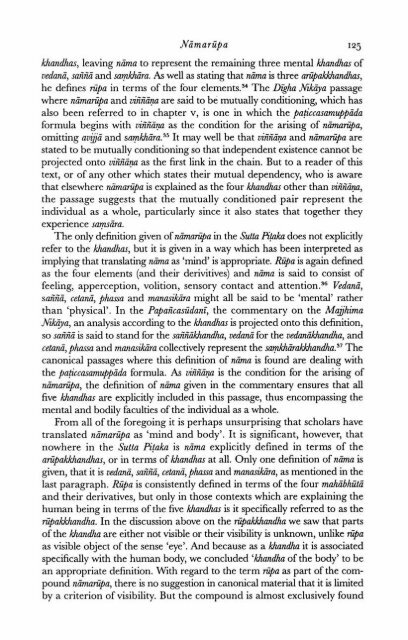Identity and Experience_Hamilton_1996
Identity and Experience_Hamilton_1996
Identity and Experience_Hamilton_1996
Create successful ePaper yourself
Turn your PDF publications into a flip-book with our unique Google optimized e-Paper software.
Wmndhas, leaving niima to represent the remaining three mental khan&a.s of<br />
vedanii, saiirii <strong>and</strong> samh-ra. As well as stating that nima is three artipfindhas,<br />
he defines rUpa in terms of the four elements.34 The wha Nikga passage<br />
where nimariipa <strong>and</strong> vin"n"iina are said to be mutually conditioning, which has<br />
also been referred to in chapter v, is one in which the paticcasamuppida<br />
formula begins with vin"n"iia as the condition for the arising of ncimariipa,<br />
omitting arnjii <strong>and</strong> sa?nkhiira." It may well be that vin"n"@<strong>and</strong> niimariipa are<br />
stated to be mutually conditioning so that independent existence cannot be<br />
projected onto zritn"igu as the first link in the chain. But to a reader of this<br />
text, or of any other which states their mutual dependency, who is aware<br />
that elsewhere nZmariipa is explained as the four kh<strong>and</strong>has other than vin'iiciy,<br />
the passage suggests that the mutually conditioned pair represent the<br />
individual as a whole, particularly since it also states that together they<br />
experience samscira.<br />
The only definition given of nimariipa in the Sutta does not explicitly<br />
refer to the Wl<strong>and</strong>has, but it is given in a way which has been interpreted as<br />
implying that translating nrima as 'mind' is 'appropriate. Rzipa is again defined<br />
as the four elements (<strong>and</strong> their derivitives) <strong>and</strong> niima is said to consist of<br />
feeling, apperception, volition, sensory contact <strong>and</strong> attenti~n.~~ VedanG?<br />
sattii, cetanii, fh.ssa <strong>and</strong> manasikira might all be said to be 'mental' rather<br />
than 'physical'. In the Papatcaszidani, the commentary on the Majhima<br />
N.iknra, an analysis according to the kh<strong>and</strong>h is projected onto this definition,<br />
so san"n"is said to st<strong>and</strong> for the san"n"&<strong>and</strong>ha, vedanii for the ued<strong>and</strong>hanndha, <strong>and</strong><br />
cetanii, pahassa <strong>and</strong> manasiEra collectively represent the ~amkhiirakW1<strong>and</strong>ha.~' The<br />
canonical passages where this definition of nima is found are dealing with<br />
the paaticcasdmuppzda formula. As zrin"n"iipz is the condition for the arising of<br />
niimariipa, the definition of niima given in the commentary ensures that all<br />
five kh<strong>and</strong>has are explicitly included in this passage, thus encompassing the<br />
mental <strong>and</strong> bodily faculties of the individual as a whole.<br />
From all of the foregoing it is perhaps unsurprising that scholars have<br />
translated niimarzipa as 'mind <strong>and</strong> body'. It is significant, however, that<br />
nowhere in the Sutta P$aka is nima explicitly defined in terms of the<br />
ariipakkh<strong>and</strong>has, or in terms of kh<strong>and</strong>has at all. Only one definition of nima is<br />
given, that it is vedami, satiiii, cetdnii, phasa <strong>and</strong> manaxikEra, as mentioned in the<br />
last paragraph. Rzipa is consistently defined in terms of the four mahcibhiiti<br />
<strong>and</strong> their derivatives, but only in those contexts which are explaining the<br />
human being in terms of the five kh<strong>and</strong>has is it specifically referred to as the<br />
nipakkh<strong>and</strong>ha. In the discussion above on the nipam<strong>and</strong>ha we saw that parts<br />
of the kh<strong>and</strong>ha are either not visible or their visibility is unknown, unlike riipa<br />
as visible object of the sense 'eye'. And because as a kh<strong>and</strong>ha it is associated<br />
specifically with the human body, we concluded 'khanttha of the body' to be<br />
an appropriate definition. With regard to the term riipa as part of the compound<br />
ncimariipa, there is no suggestion in canonical material that it is limited<br />
by a criterion of visibility. But the compound is almost exclusively found


